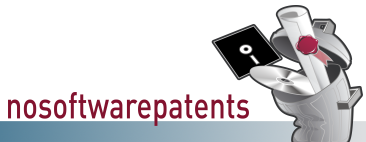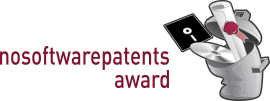| English | Deutsch |

![- Logo]](../images/layout007-small.png)
| Home |
| Software Patent of the year 2006 |
| About |
| Supporters |
| Background |
| News |
| Press November |
| Links |
| Contact |
| Imprint |
Juni – Patent 5
- EU-Patent on software (algorithm)
- Application to European Patent Office on 09/07/1998 by Nielsen Media Research, Inc. (USA)
- Granted on 01/06/2005
- Date of priority: 12/05/1998 (valid no more than until 12/05/2018)
- Patent attorney: von Samson-Himmelstjerna, Friedrich R. et al, Samson & Partner
- specification provided by FFII/Gauss
- Patent specification provided by EPO/espacenet
- The decisive element are the claims, as they specify which actions are forbidden within the framework of the patent.
- Violating one single claim is sufficient to be considered a patent violation. Generally, claim number 1 is the decisive main claim which covers all other claims relating to special cases.
- The description is intended to help the reader interpret the claim. At the same time, it is supposed to document and disclose the details of the invention. This disclosure is the original purpose of the entire patent system.
- In practice, a patent specification contains no detailed information on how the patented procedure could be implemented (even if the patent owner allowed the implementation). In particular, a software patent contains no program code (reference implementation), but merely describes the idea of a software.
Patented idea: Identifying the television program by means of the tone
Main claim: If the television program is not identifiable by means of direct coding, identification happens by means of the tone and by means of comparing it with the transmitted audio signal of all the television channels.
Further claims:
- Particular cases: Identification of the tone by means of a microphone incorporated in the television receiver
- Installation of the software in the television set
Description: Digital television must do without some possibilities of program identification which can be applied in case of analogue television. Concerning the video signal modifications are more significant than in case of the audio signal. The resulting approach to solving the problem is patented. The patent specification itself points out that there is merely patented an idea, whereas the "invention" until then had not been realised.
Everyday parallel: Eavesdropping at the door of a neighbour in order to find out which television program he or she is watching.
Examples for patent infringements: As described in the patent specification, the problem results from
the implementation of digital television and the patented idea
arises in natural ways from the characteristics of digital
television. Programmers working in the area of television audience
measurement are likely to find the same solution and would infringe
the patent.
| Previous Software Patents of the Month |
| > September |
| > August |
| > July |
| > June |
| Patent 1 | |
| Patent 2 | |
| Patent 3 | |
| Patent 4 | |
| Patent 5 |
| > May |
| > April |
| > March |
| Press Archive |
| > Oktober |
| > September |
| > August |
| > July |
| > June |
| > May |
| > April |
| > March |
